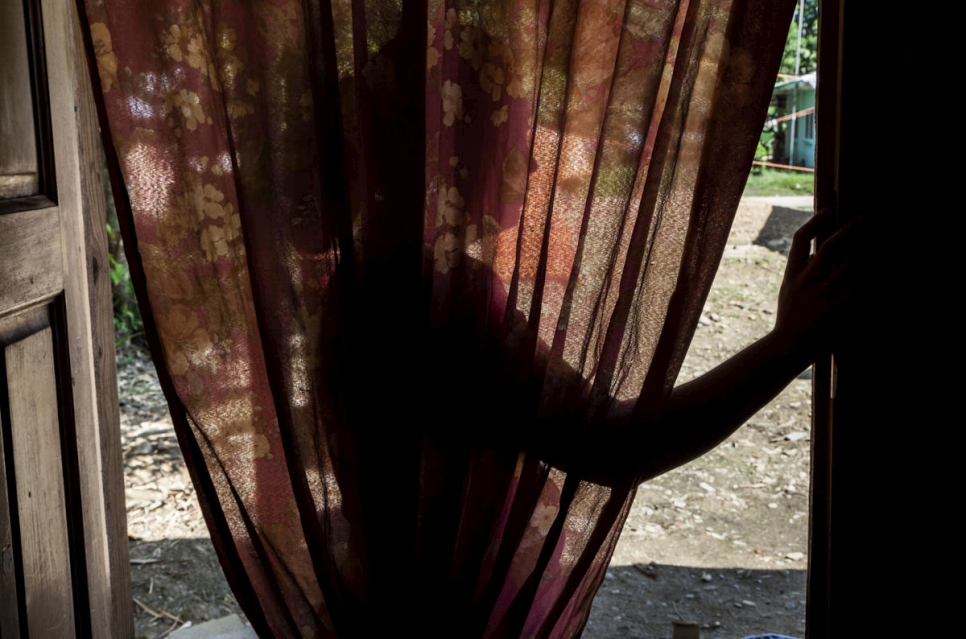Central America's displacement crisis aggravated by COVID-19
This is a summary of what was said by UNHCR spokesperson Andrej Mahecic – to whom quoted text may be attributed – at today's press briefing at the Palais des Nations in Geneva.

A refugee who fled gang violence several times in Honduras starts over in Belize, January 2019. © UNHCR/Diana Diaz
An escalating situation of chronic violence and insecurity, coupled with COVID-related restrictions, is risking lives and exacerbating hardship for tens of thousands of people in the north of Central America, warns UNHCR, the UN Refugee Agency.
Violence has forced some 720,000 people in the region to flee their homes, as of the end of last year. Almost half of them are now displaced within their own country, including some 247,000 people in Honduras and some 71,500 in El Salvador, while others have fled across borders.
Today, despite COVID-related lockdowns in Honduras, El Salvador and Guatemala, internally displaced people (IDPs) and community leaders report that criminal groups are using the confinement to strengthen their control over communities. This includes the stepping up of extortion, drug trafficking and sexual and gender-based violence, and using forced disappearances, murders, and death threats against those that do not comply.
Restrictions on movement make it harder for those that need help and protection to obtain it, and those that need to flee to save their lives are facing increased hurdles to find safety.
In addition, strict lockdowns have resulted in many displaced and vulnerable people losing their livelihoods.
As businesses are ordered to close and informal jobs vanish, people living in these vulnerable communities are losing their only sources of income.
Many now have limited access to basic services like healthcare and running water. Faced with these dire circumstances, people are increasingly resorting to negative coping mechanisms – including sex work -- that put them at further risk both in terms of health and by exposing themselves to violence and exploitation by the gangs.
The intra-urban nature of internal displacement in the north of Central America, and the fact that it often involves one person or family at a time, can make new forced movements difficult to detect.
UNHCR regularly relies on a network of community leaders in high risk areas to identify possible internal displacement. They have told UNHCR that they expect a rapid increase in forced displacement as soon as the lockdown measures are lifted.
In the meantime, UNHCR is working across the north of Central America, concentrating on the most critical humanitarian interventions to the extent that movement restrictions allow.
To provide protection to people under threats and violence, UNHCR coordinates with Ombudsperson’s Offices and partners in Honduras and El Salvador to ensure a timely response on behalf of state authorities to imminent risks.
We also provide remote counselling, and work with shelters for especially high-risk cases, coordinating movements with the authorities.
To help mitigate the impact of loss of income of displaced and at-risk communities, UNHCR has scaled-up its cash assistance programmes to help IDPs meet basic needs such as food, medicines and housing. We are also working with partner organizations, and local authorities to distribute food baskets and cleaning items.
The impact of the pandemic in the north of Central America risks setting back the progress that was being made towards creating livelihoods and job opportunities for IDPs; and in building the capacity of state authorities to address their needs, including through the creation and implementation of laws and policies that seek to advance their rights.
UNHCR remains ready to support efforts by state authorities to continue to address the needs of the internally displaced and at-risk communities in line with international commitments made through the regional framework for the comprehensive protection and solutions to forced displacement in Central America – known as MIRPS.
For a complete picture of forced displacement in Central America and Mexico visit the UNHCR operational data portal https://data2.unhcr.org/en/situations/cam/location?secret=unhcrrestricted
For more information on this topic, please contact:
- In Mexico, Sibylla Brodzinsky, [email protected], + 52 55 8048 5054
- In Panama, William Spindler, [email protected], +507 6382 7815
- In Panama, Diana Diaz, [email protected], + +507 6646-3469
- In New York, Kathryn Mahoney, [email protected], +1 347 443 7646
- In Geneva, Shabia Mantoo, [email protected], +41 79 337 7650
